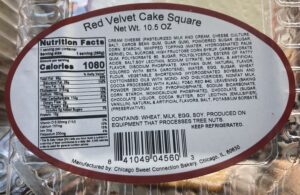What is a Processed Food?
The term “Processed” refers to anything that changes a food from its original form. The USDA lists it as anything that has been crushed, cut, chopped, diced, sliced, pitted, blended, pureed, juiced, or dried. So that would also include any food that has been cooked, canned, frozen, fortified, or preserved.
We process foods all the time in our kitchens, with our “food processors” and blenders and stoves. Just because a food is processed does not necessarily mean it’s bad for us, However, the MORE processed a food is, the more health risks it poses.
The Level of Processing
There are several levels of processing when it comes to packaged foods.
Minimally Processed Foods are processed at their peak freshness to lock in nutritional quality and freshness, including foods such as frozen fruits and vegetables, pre-cut vegetables, bagged lettuce and greens, and canned tomatoes.
Other definitions of "minimally processed" include foods that have undergone processes such as drying, freezing, or vacuum packaging that change their original state, but do not anything to the original food; Butler soy curls would be a great example.
Moving up the spectrum a bit comes Processed Foods; foods which might be altered in some way, or fortified with various nutrients such as calcium, vitamin D, or other vitamins and minerals. Ingredients are sometimes added for flavor and texture as well, such as oils, sweeteners, spices, and preservatives. Examples would include breakfast cereals, jarred pasta sauce, salad dressings, certain crackers, breads, and pastas.
And then we have the Ultra-Processed Foods (UPFs) – which have significantly changed the makeup of the original food. These foods are the worst of the worst. Sometimes called “highly-processed,” these foods have been altered to include fats, oils, sodium, sugars, dyes, and hydrogenated oils extracted from other foods. The added sugars in UPFs is 8-fold higher than in processed foods, which is one of the biggest contributors to our obesity rates.
UPFs are also typically loaded with additives and preservatives to maintain a long shelf life. Because of the sugars, fats, and salt, these foods contribute to something called “The bliss point" in our brains, which gets us hooked on these foods and keep us going back for more. Manufacturers know this and actually formulate their foods with The Bliss Point in mind.
Examples of UPF's
Ultra-processed foods include things such as frozen meals, pre-made microwave meals, canned convenience foods, packaged soups, granola bars, cookies and bakery items, candy, fake cheeses and meat analogs, fried foods, sugary breakfast cereals, chips and soda pop. And that's just the tip of the iceburg.
Who Eats the Most UPF's?
You might wonder how much ultra-processed foods Americans are eating? Surprisingly, 73% of the foods on American grocery store shelves are Ultra Processed foods. As a result, it's NOT so surprising that the U.S. ranks as the top consumers of UPFs, with The UK and Canada close behind. Industrialization is a big predictor for this, because the production of UPF’s requires large-scale factories and industrially produced additives.
UPF’s comprise 58% of the calories consumed by adults in the U.S. Think about that for a second. That is a huge number. The British and Canadian populations are also consuming over half their calories in ready-to-eat, UPFs.
But even more disturbing is that, according to a Tufts University study of nearly 34,000 people, kids and teens are now consuming 67% of their total caloric intake from UPF's!
How are UPF’s impacting our health?
Unfortunately, health outcomes are not isolated to one specific health condition, but rather a group of chronic diseases “including all-cause and cause-specific mortality, cardiovascular disease (CVD), overweight and obesity, body composition and fat deposition, diabetes, cancer, and gastrointestinal and other diseases.”
As the frequency of UPF consumption increases in an individual's diet, the risk of all-cause mortality also rises, even when studies control for other variables such as smoking, physical activity, or poverty level. The more UPF's Americans consume, the higher their risk of total, abdominal, and visceral obesity, starting as early as childhood.
Metabolic Syndrome
Research published in 2020 by Cambridge University Press, which did a meta-analysis of 23 studies, reported that high consumption of UPFs is associated with a significant risk increase for obesity, lowering good cholesterol, and metabolic syndrome.
Metabolic Syndrome is a group of five conditions that can lead to heart disease, diabetes, stroke and other problems, and the five factors are high blood sugar, high triglycerides, high blood pressure, low levels of HDL/good cholesterol, and a large waist circumference. When a person has three or more of these conditions, they’re diagnosed with metabolic syndrome because the chance of developing cardiovascular disease increases.
Additionally, data from five studies, totaling over 230,000 adults from four different countries, found that a higher intake of UPF’s was significantly associated with an increased risk for Type 2 Diabetes.
And then there’s THIS: A systematic umbrella review published in Feb. 2024 by the British Medical Journal, where researchers evaluated 45 meta-analyses consisting of nearly 10 MILLION people, found convincing evidence that supports direct associations between exposure to UPF’s and higher risks for cardiovascular disease, diabetes, anxiety and mental health disorders, obesity, sleep problems, and premature death.
Mental Health
One more HUGE health factor is that the added sugar, salt, oils, fats, and additives in UPFs all contribute to inflammation, which is directly correlated with a variety of diseases. As people consume UPFs at higher and higher levels, the health of the gut microbiome is jeopardized, and their mental health is affected as well.
Inflammation markers measured in the blood were found to be significantly elevated in those with major depressive disorder, autism spectrum disorder, post-traumatic stress disorder, bipolar disorder, and schizophrenia. Altogether, UPFs play a multifaceted role in the declining mental health of Americans because of the high consumption.
Not All Processed Foods are Bad.
If you follow a healthy eating plan, most of the foods in your grocery cart will consist of fresh produce, frozen fruits and vegetables, and items from the dry bulk section. But there are many acceptable items that come in cans, jars, or boxes, too.
Certain packaged foods such as canned beans, frozen vegetables, salsa, marinara sauce, whole grain pasta, and certain cereals can be a part of a healthy diet, but the only way you’ll truly know if a product is acceptable or harmful is to read the label.
Read Your Labels!
Packaged, processed products are some of the most deceptive foods out there, and you’d be surprised at how many products promoted as “healthy” are filled with junk ingredients.
Label reading is crucial in order to know if a packaged food is healthy or NOT.
At the time of this writing (June 2024), I'm developing an in-depth Label Reading Class which will release soon. You can check for it's availability by clicking on the "courses" tab on my website: https://cydnotter.com.
In the meantime, please examine the packaged and processed foods/ fast foods you and your family are consuming. It's just not worth dying early or spending the last 15 years of your life suffering with a myriad of preventable health conditions.
I'm here to help you through courses and online cooking demos. I also offer personal coaching services if you'd like personalized help and accountability. To learn more about my coaching services, please watch this free webinar. At the end, you'll be given the chance to schedule a complimentary call with no strings attached.
https://bmjopen.bmj.com/content/6/3/e009892
https://jamanetwork.com/journals/jama/fullarticle/2782866
UPFs and Health: a 2020 study at Cambridge University https://www.ncbi.nlm.nih.gov/pmc/articles/PMC7844609/
https://www.ncbi.nlm.nih.gov/pmc/articles/PMC8705763/
https://www.bmj.com/content/384/bmj-2023-077310




